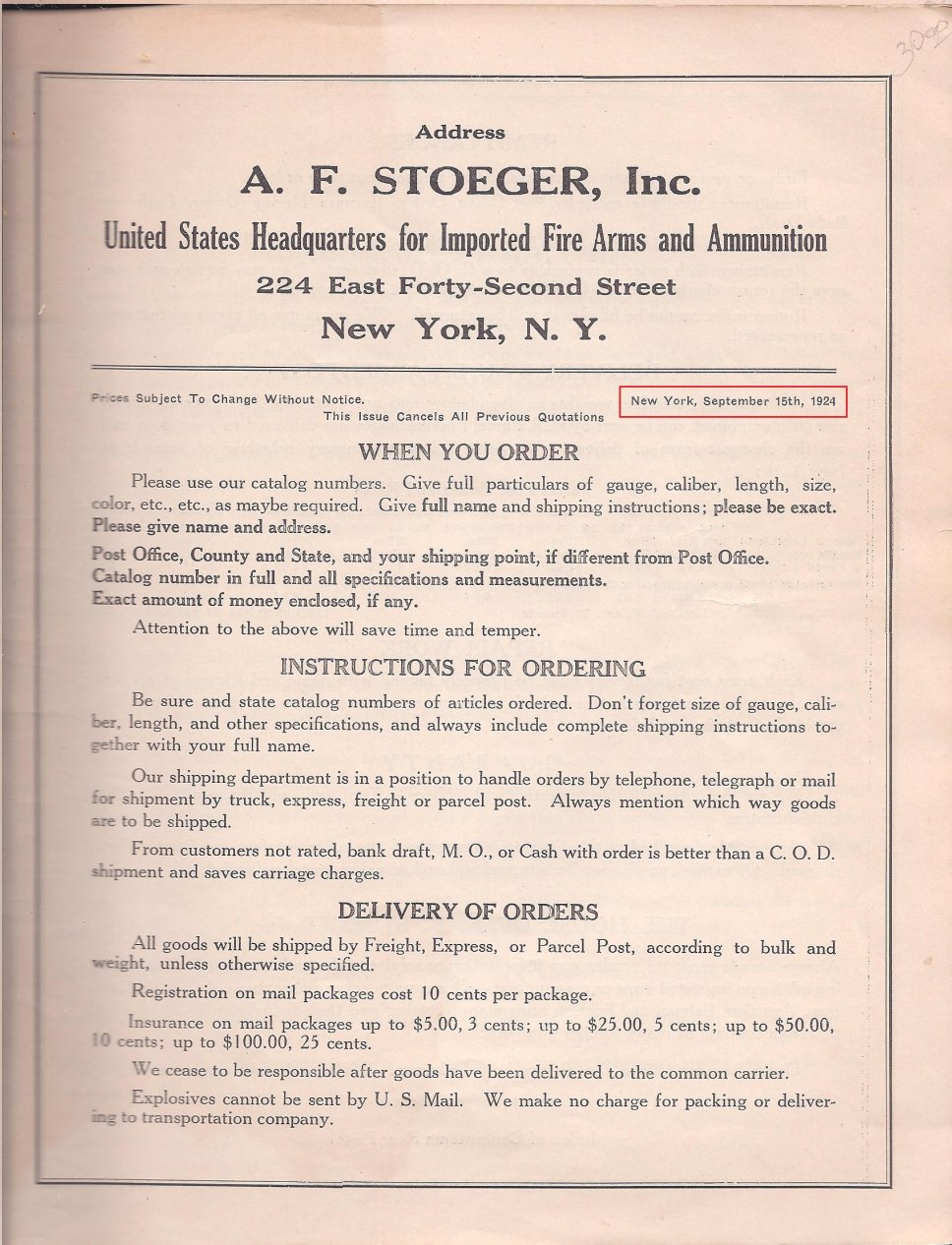buttons
In 1964 the Stoeger Arms Corporation published a reprint of the PARABELLUM Automatic Pistol owners’ manual. A small section in the rear of the manual was dedicated to the history of A.F. Stoeger from the beginnings in the 1920s to the current day. All materiel presented was from the company’s’ own records and is still considered quite accurate today. All later Luger books and publications when discussing “Stoeger Lugers” use the 1964 Stoeger publication as source material, and as such, no new company information of consequence has been identified since 1964, with the exception of better identifying the variations through the observation of many specimens. New information is sometimes discovered in the form of the identification of unusual variation Stoeger Lugers that fills a gap and adds to the Stoeger story. Discussed and pictured herein is one such unique Stoeger Luger variation.

Previous page Next page
BACKGROUND
Manufactured by DWM for Stoeger Arms Corp. for sale in the U.S. Some examples have an additional marking on the right frame rail. This inscription may be “LUGER REGISTERED U.S. PATENT OFFICE,” or the word “ORIGINAL” or “GENUINE” may appear before the word “LUGER.” Although the barrels are usually found in the 3 5/8 to 8 inch lengths, some are noted in lengths up to 24 inches. These long barrels were offered installed or separately by Stoeger. Any combination of chamber marking, extractor marking, and safety lever marking is possible. The example shown has “LOADED” extractor markings, “SAFE” safety lever markings, and has a four digit serial number followed by the letter “t”. Do not confuse these 1923 STOEGERS with the later produced Stoegers manufactured by MAUSER (see MAUSER catalogue section).
The above benchmark description was written in 1968 by Charlie Kenyon, Jr. in Lugers At Random and although mostly accurate, is a bit conflicting as he states some of the 1923 2-line Stoeger Lugers may have the added right side “third-line” frame rail inscription, yet states in the same description that: Do not confuse these 1923 STOEGERS with the later produced Stoegers manufactured by MAUSER (see MAUSER catalogue section). The description is of the 1923 Stoeger 2-line, right side receiver inscription of “A.F. STOEGER, INC. - NEW YORK.”, which was on the right side forward receiver of many Stoeger DWM/BKIW early contract 1921 - 1930 imported Stoeger Lugers. The most interesting aspect of the Kenyon description is that it acknowledges or implies, as stated above, that some contract 1920s DWM/BKIW examples have an additional third-line stamping on the right side frame rail with a combination of words from “LUGER REGISTERED U.S. PATENT OFFICE,” or the word “ORIGINAL” or “GENUINE” may appear before the word “LUGER”. The only examples pictured of the 1923 DWM Stoeger variation are with the 2-line receiver markings only, and are roll die stampings. Why the additional roll die frame rail stamping would be encountered on the 1920-1930 manufactured Model 1923 commercial Luger is difficult to explain since the October 5, 1929 Stoeger submitted U.S. patent application for the word “LUGER” wasn’t granted or registered until April 22, 1930. It wasn’t until after 1930 when the Mauser manufacture of the continuing, existing Stoeger contract with Mauser, assembled Stoeger commercial Lugers, that were consistently 3-line roll die stamped under the blue by Mauser, the Stoeger requested third line, being roll die applied on the right side frame rail, initially being: LUGER – REGISTERED U.S. PATENT OFFICE and the word GENUINE, at first not used, being added later at the special request of Stoeger. The right side frame rail added word GENUINE has been observed perfectly aligned and sometimes not so perfectly aligned. A possible scenario is that the perfectly aligned examples were roll die applied, as part of the complete stamping, to later assemblies per Stoegers’ request vs. the misaligned examples, being added to completed assemblies, per Stoegers’ request. Since the added misaligned word GENUINE is the same font size and style the aligned examples, both variations were roll die stamped at the Mauser factory, prior to delivery.
1923 Stoeger Luger, serial number 1107
Pictured is a very unusual variation 3-line Stoeger Luger, no letter suffix serial number 1107 with the third-line being an added, abbreviated “interim” patent statement on the right side frame rail. The gun is a 1923 BKIW 2-line Stoeger contract Luger, assembled in 1929 or 1930, consisting of a DWM/BKIW Stoeger contract frame, 2-line receiver, and toggle link assembly. The 100 mm 30 Cal barrel is BKIW made and C/N proofed, through the blue, with a no-letter suffix BKIW stamped serial number 1107, also through the blue. The high polish finished side plate, which is not serial numbered, and no serial numbered wooden grips are of BKIW manufacture. The BKIW receiver is vertical C/N stamped. There is a faint C/N pressure proof stamp on the breechblock, which has a GELADEN stamped extractor. The extractor is original to the breechblock as the underside of the extractor is stamped 28 with the same number stamped on the rear of the breechblock. There is an upper case D stamped on the front face of the barrel sight block, which is found on other BKIW barrels, an example being another early 1930s Mauser commercial/Police Luger, serial number 873V, except with the no letter suffix 873 stamped barrel underside, being Mauser double C/N proofed. The side plate of 1107 is not numbered and the finish is a bright blue. “GERMANY” is stamped in two places, one on the receiver right side, under the blue, and on the frame, under the serial number, through the blue. This is not the first instance of a Luger being stamped GERMANY in two locations and has been observed on other late 1920s BKIW assembled 2-line Stoeger Lugers. Most 2 and 3-line Stoeger receivers have the GERMANY export stamp and some observed 2-line receivers do not. The frame and barrel 4-digit serial numbers were applied by BKIW with the frame serial number correctly stamped under the blue and barrel serial number stamped through the blue. The rear link 07 serial number is of the same number font size and style as the frame and barrel full serial numbers, which are identical in size and number font style to the above mentioned 873V and is similar to the early serial number stampings of a 1931 contract Dutch Royal Navy Parabellum, an example being 1857. The only other 07 numbered small parts are the take-down lever and trigger. The middle link and breechblock are not numbered, although the breechblock is correctly C/N proofed, typical for 1920s DWM commercial components.
The subject serial number 1107 2-line Stoeger Luger is the first published example of a no-letter suffix serial number 29 DWM/BKIW commercial Luger. Based on the 100mm barrel length and other characteristics this would be described by Jan Still in Weimar Lugers on page 14, as a 29 DWM gun in the i and u suffix range, being assembled in 1929-1930 by BKIW, Table 1a titled: BKIW-MAUSER TRANSITIONAL LUGER (ABBREVIATED 29 DWM), however, this example is without a frame serial number letter suffix. Page 13, Table 1a COMMERCIAL SN RANGE VARIATIONS Produced 1921-1928 does list a “Stoeger 2-line commercial” category of apparently no-letter suffix Lugers, however, does not elaborate on this category in text or pictured example, leaving a dead-end.
There is no doubt as to the authenticity of the gun, including the frame receiver/barrel assembly and toggle link assembly being totally correct and that it was totally assembled by BKIW, specifically for contract export to Stoeger in New York. These observations are based on the following:
- The thumb safety frame recess stamping of SAFE,
- combined with the GERMANY export stamp, through the blue, on the front of the frame, located under the 4-digit no suffix serial number 1107, which was stamped prior to bluing.
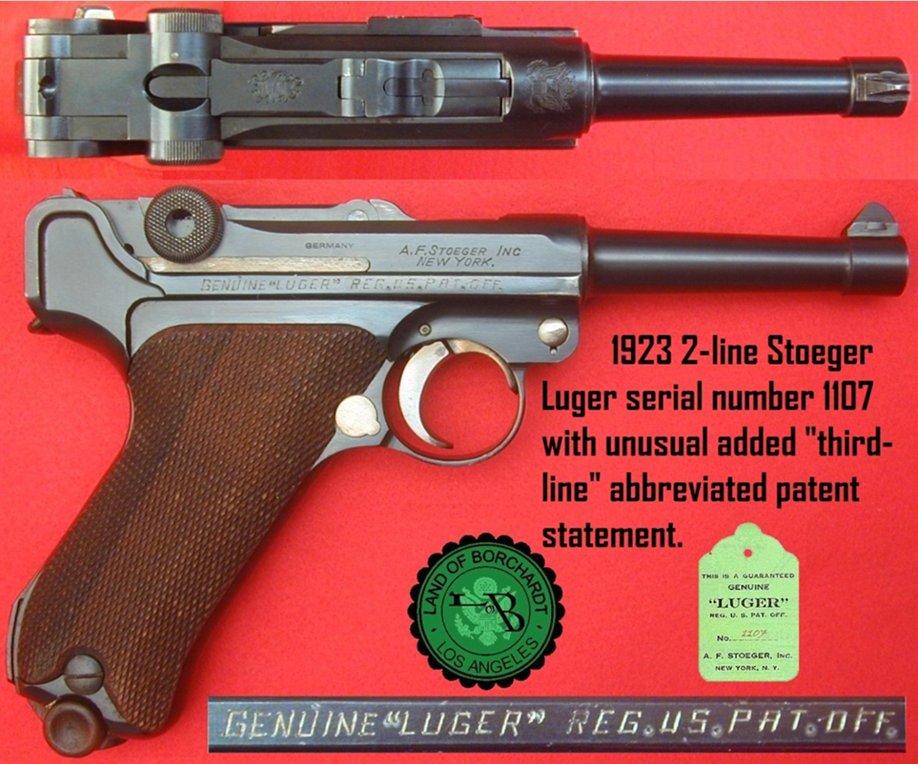
The American Eagle chamber crested vertical C/N proofed receiver with A.F. STOEGER - NEW YORK. is roll die stamped on the right forward receiver, along with a GERMANY export stamp, both applied prior to bluing, is typical of a correct Stoeger contract 2-line receiver. The installed 100mm in length original barrel, which is the normal length for a late 1920s BKIW 30 Cal barrel, is correctly stamped with the 1107 serial number on the barrel underside, through the blue, with the identical font size and style as the frame serial number stamp. The toggle link assembly, albeit with a GELADEN stamped extractor, is also totally correct, with the rear link being stamped with the last 2-digits of the serial number 07 with the same size and font style as the frame, and barrel full serial numbers. With the barrel C/N being stamped under the blue makes this Luger totally assembled by BKIW in 1929-1930. The highly polished take-down side plate is curiously, as mentioned earlier is not numbered, however, this is also common to commercial DWM/BKIW Lugers manufactured in the 1920s.
Much has been written about Stoeger Lugers and the 2 and 3-line inscriptions, therefore is not discussed, however, some materiel being briefly rehashed here, considered germane to the subject Stoeger Luger 1107. Regarding the right side frame rail added third-line inscription of 1107, the first thought that goes through the collectors mind is fake or boosted, however, if one was trying to boost an otherwise original 2-line inscription Stoeger Luger, the logical effort would be to replicate the well-recognized, to collectors, roll die inscription of: GENUINE LUGER – REGISTERED U.S. PATENT OFFICE, found on the 1930s Mauser made 3-line contract Stoeger Lugers. As to where, i.e., what country, Germany or the United States, added the third-line to the right side frame rail of the subject 1107 original 2-line inscription Stoeger Luger, would be the United States, by Stoeger sometime after receipt, based, partly, on the word “LUGER” in closed quotes. If the third-line inscription was added in Germany by Mauser, then possibly the closed quotes would be applied per the German style of “low 9” and reversed quotes enclosing of the word Luger and would be at the bottom of the L or „LUGER”. In fact the added third-line inscription of “LUGER” is similar to the statement found in the 1924 through 1930 Stoeger sales catalogs, where it advertises the Luger, under the general lead statement of:

and is, in fact the inscription, it turns out, is extremely close to the phrase used on the never seen or published, very distinctive Stoeger green colored ID or sales tag, attached to a typical period Stoeger Luger for sale, either being provided by the Stoeger firm to a retail outlet offering Stoeger Lugers or attached directly to guns as delivered to the retailers or jobbers as stated on the cover page of the earliest dated 1924 Stoeger catalog.
1929 A.F. Stoeger, Inc. patent application
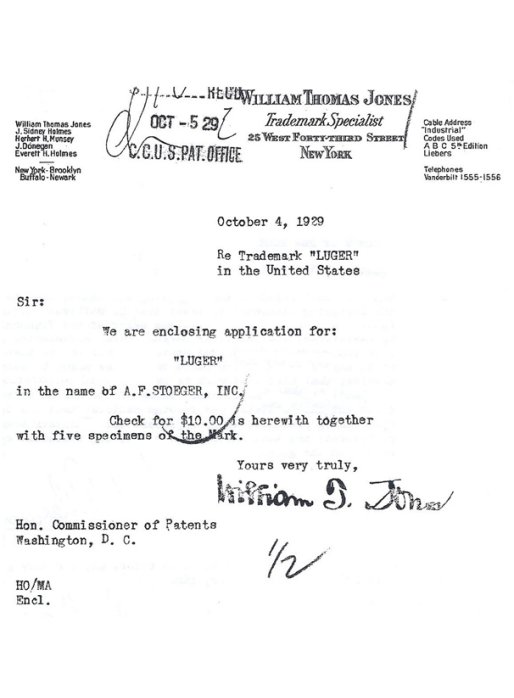 Run mouse over patent image to see all the pages of the application.
|
The pictured Stoeger sales or price tag, interestingly, was part of the 1929 A.F. Stoeger, Inc. patent application submission or Luger trademark specimen package of five different trademark examples and is part of the current, residing United States patent records. The information on this tag most closely supports the source for the 1107 frame rail inscription:

as this tag, as stated above, was part of the original 1929 Stoeger patent application submission that included five specimens, which the submitted paperwork also states that: and presented herewith five specimens showing the trademark as actually used by applicant upon the goods, and requests that the same be registered in the United States Patent Office in accordance with the act of February 20, 1905, as amended. This information was obtained through the United States Patent Office records. Most importantly is the fact that these five specimens consisted of: Shotguns, pistols, revolvers, rifles and parts thereof; It is possible therefore, though highly unlikely, that the subject 1107 Stoeger Luger or a similarly frame rail marked 2-line Stoeger Luger was one of the specimens (pistol) submitted to the U.S. patent office with the inscription, along with the Stoeger green ID price tag with, basically, with the identical frame rail text as the pistol.
A discrepancy in the Stoeger patent application is difficult to explain, since the Stoeger company was only founded in 1919, is the October 5, 1929 U.S. Patent Office records Stoeger application statement that the (submitted) LUGER registration name, i.e. “mark”: The trademark has been continuously used in the business of applicant since Feb 1, 1895.
As stated above, it is highly unlikely that real specimens, five as mentioned, were submitted, rather the word specimen referred to pictures, photographs or other such renderings, as an interpretation of the final paragraph which states; The Trademark is printed or stamped on:
- labels,
- (price) tags which are affixed to the goods,
- containers for the goods;
- the Trademark is stamped directly on the goods or,
- containers.
Yet the Stoeger cover letter dated October 4, 1929, date stamped received OCT-5 29, is clear with the very specific statement of: Sir: We are enclosing application for: “LUGER” in the name of A.F. Stoeger, Inc. Check for $10.00 is herewith together with five specimens of the mark. The only surviving and most notable specimen as part of the October 4, 1929 enclosure is a green retailers identification price hang tag to be attached (affixed to the goods) to all subsequent Stoeger Lugers in inventory or for sale. Pictured is the A.F. Stoeger, Inc. green retail sales hang tag, specimen 2 of 5, as it currently resides in the U.S. Patent office files as part of the original, October 4, 1929 A.F. Stoeger, Inc. patent Trade-Mark 269, 834 application package submittal, consisting of five specimens.
First theory for the added frame rail engraved inscription
This was apparently Stoegers first choice for the frame rail “third-line” inscription as interestingly, the tag description, being one of the five submitted specimens as part of the U.S. Patent Office October 5, 1929 Stoeger patent application, Serial No. 290, 722, not approved or registered by the U.S. Patent Office until April 22, 1930 as Trade-Mark 269, 834, contains all the elements, or key phrases for the subject 1107 third-line frame rail inscription. The normally blank retailers price tags were a standard item, available at any stationary store, then and now, and Stoeger, no doubt, special ordered many with the patent information printed on the tag, however, due the size of the tag the printer had to use abbreviations, hence “REG. U.S. PAT. OFF.” and with similar length restrictions with the frame rail inscription, even with the use of the smallest possible engraving application, the Stoeger engraving department employee also had to use abbreviated words to get the entire statement on the right side frame rail of 1107. This restriction was obviously overcome by Mauser, using a combination of a smaller font size, combined with a tighter grouping of the characters and most importantly was roll die applied.
Regarding the 1107 added right side frame rail inscription, it is a very professional engraving, consisting of all straight lines applied at a slight angle, probably done to agree with the existing, angled receiver 2-line stamp. The closed quotes around “LUGER” were cleverly accented or completed by using a circular punch at the tips, as evidenced by the slight halo made by the strike. The actual straight lines making up the 2.25mm high letters were engraved, accounting for the lack of any discernible halo and only the slight hint of displaced metal. The frame was clamped for the application and some sort of simple jig was used to align the lower edge of the letter characters, of which the entire inscription is quite even with, predictably, some uneven upper letter height terminations. The overall appearance of the added frame rail inscription is quite acceptable when normally viewed at arm’s length. It should be mentioned that A.F. Stoeger, Inc. did have “expert”, professional in-house engraving and other marking capabilities as early as 1924, as stated in their 1924 copyright © dated Stoeger sales catalog on page 4.
The Stoeger catalogs are not, in regards to the evolution of the inscriptions, very revealing in the advertising thought process of A.F. Stoeger where, in the first catalog advertising the Luger in 1924, specifically, the emphasis is on the word “LUGER”, bearing in mind that as of 1922 Stoeger had “wrestled” the sole Luger franchise from Hugo Panzer. While Stoeger went to the effort of emphasizing the word “LUGER” yet, despite that, the 1924 catalog advertisement for the Luger made no mention of the 2-line A.F.STOEGER INC – NEW YORK., right side receiver inscription, nor is it shown on the pictured Luger.
1924? 1925?
An interesting side story is the issue of what should be considered the very first published Stoeger sales catalog. Pictured in Luger Holsters and Accessories of the 20th Century by E. Bender on page 615 is an A.F. Stoeger, Inc. sales catalog cover with the Bender caption: The First Stoeger catalog ever issued appeared in 1925. This is further suggested by an additional statement under the catalog: This cover from the very first Stoeger catalog was lovingly inscribed by A.F. Stoeger and identified as “my first effort – A.F. Stoeger.” This claim is very difficult to dispute, being hand written on the catalog cover in Stoegers own hand writing, with his signature. The credit at the top of the catalog cover additionally states: Stoeger, Inc.: Reproduced by permission. The problem is that part of the Land of Borchardt collection is an original A.F. Stoeger, Inc. sales catalog with identical cover graphics and with identical text, with one minor difference, it has a document copyright © date of 1924, i.e. ©A.F.S. 1924 or A.F. Stoeger, copyright ©1924 that is, in fact, one year earlier than the Bender claim. In addition, page 1 of the 1924 catalog is dated September 15th, 1924. In support of the 1924 first Stoeger copyright dated catalog date is another example being a Stoeger ad featured in a 1924 magazine.
The “1925” Bender catalog cover has a similar ©A.F.S. or A.F. Stoeger, Copyright©---- statement, except it is undated which, sort of, clouds the apparently, solely Bender claim of 1925 as being the very first Stoeger sales catalog, is unsupportable, and not based on reliable source data. There is no doubt the Bender picture of the undated Stoeger catalog was indeed Stoegers “first effort”, however, the Stoeger hand written cover statement of “My first effort” is generic in nature and is chronologically non-committal or vague, whereas, the 1924 dated document copyright statement located on the Land of Borchardt original Stoeger sales catalog cover is irrefutable.
Furthermore, there exists, also as part of the Land of Borchardt collection, an identical 1925 A.F. Stoeger, Inc. catalog with a cover, except presented herein in color, identical to the black and white Bender cover with the year of publication confirmed by a 1925 dated page 1. On the cover of the 1925 color catalog cover is hand written, in pencil, April 1925. This suggests the catalog was issued as early as April 1925, if not earlier, in comparison to the rather late 4th quarter September 15th, 1924 printing of the original 1924 Stoeger catalog, dismissing the contention of the existence of a 1923 catalog. In other words, it took Stoeger most of 1924 to put together his first catalog. Curiously, the 1924 cover page, well-known Stoeger logo of the Auerhahn (grouse) with the dated copyright statement is pictured on the front cover only,1 whereas by the 1930 Catalog No. 14 and the 1930-31 Catalog No.15 winter catalog, the same no copyright dated Stoeger unofficial Auerhahn logo not only appears on the covers, but on each page in the catalogs, again a publishing enigma, as there are two versions of the Auerhahn logo in the 1930 and 1930-31 catalogs, one with a no-date copyright statement and another with a copyright statement of 1924, indiscriminately placed on each page of the catalogs.
All subsequent Stoeger sales catalog covers published in the 1930s, curiously, have an undated document © A.F.S. copyright statement. However, most catalogs are clearly identified with the year of publication by the prominent placement of the full 4-digit numeric year on the cover, centrally located, no less, in two places on the left and right side of the cover page as shown by this example catalog.
The Stoeger Patent No. 290, 722 application for the LUGER trademark name was filed October 5, 1929, and registered by the United States Patent Office April 22, 1930. Apparently this was too late for the 1930 Stoeger sales catalog issue, as the 1930 Stoeger sales catalog advertisement makes no mention of the newly added 3-line right frame rail inscription. However, it does state for the first time: …and to further insure identification all our Lugers are stamped on the right forward side of the receiver “A. F. Stoeger, Inc., New York”., which has been on Stoeger receivers since the early 1920s. Yet the pictured Luger still does not show the 2-line inscription it describes in text. It is not known which year the text statement for the 2-line inscription first appeared in a Stoeger sales catalog ad for the Luger.
It was not until the 1931 Stoeger catalog that pictures a Luger, possibly for the first time, showing the receiver 2-line and the Mauser added frame rail third-line patent inscription. Curiously, an arrow is pointing to the 2-line receiver inscription only and not pointing to the newly registered added frame rail third-line or 3-line Stoeger Luger, final version Luger patent statement, including the word GENUINE. Also, the text description is the same as in the 1930 catalog, with no mention of the pictured third-line inscription, which includes GENUINE, perfectly aligned; same font size and style. However, it did mention for the first time, the American Eagle chamber crest. A similar ad, except with two 3-line Mauser Stoeger Lugers is pictured in the 1940 Stoeger catalog, indicating a still existing stock of unsold Stoeger 3-line marked Lugers from the 1930-1934 Stoeger/Mauser contract production range.
It is in the time frame of 1929 - 1930 that the Stoeger/BKIW subject late 1920s DWM/BKIW 2-line contract Stoeger Luger serial number 1107 was assembled. When received in New York as part of a batch of BKIW contract American Eagle Lugers for Stoeger, the first theory for the added frame rail engraved inscription presented is preferred. An alternate scenario possibility is that Stoeger, Inc., who was anxious to promote their new “LUGER” trademark registration approval, added the first draft interim third-line inscription to the frame rail. This may have been done for store samples only. With most certainty, the 2-line Stoeger Luger serial number 1107 was part of Stoeger inventory, prior to the April 1930 “LUGER” trademark registration approval.
All subsequent V suffix series Mauser contract Stoeger Lugers were delivered with the final, unabbreviated version, right side frame rail inscription, roll die applied by Mauser. Regarding the subject 1107 third-line inscription, as an alternate scenario, is not the first instance of a manufacture getting ahead of the patent approval process as the Audley Safety holster is stamped “Patent Pending” on the product prior to patent approval, although, in the case of the subject Stoeger Luger, Stoeger had not yet, although possibly in the process of, submitted or not quite yet obtained patent registration approval when the third-line patent affirmation inscription statement was added to 1107.

Regarding the presence, or lack thereof, of the word “GENUINE” in the Mauser Stoeger third-line inscription, some authors and collectors contend that Mauser did not want or resisted until requested by Stoeger, want to add the word Genuine as it would somehow imply that other Mauser made Lugers were not “Genuine” is plausible, but not the only explanation. Mauser, like any company, was in the business to sell products and make money. The fact that Mauser used the well-known and recognized “saleable” DWM logo on the early Mauser made Lugers, is not necessarily due, solely to the expedient use of DWM parts, but more to the recognized sale potential of the DWM name, rather than their own logo, is testimony to their monetary priorities. The fact that the GENUINEwas added later by Stoeger and/or Mauser can be simply attributed to an afterthought to boost sales.
There will always be controversy regarding the unusual third-line inscription on the subject 2-line Stoeger Luger, although the originality or authenticity of 1107 as a unique Stoeger Luger variant cannot be successfully challenged; the third-line added inscription though, can and will be challenged, however, the overwhelming circumstantial evidence presented herein is a compelling argument or theory that errs toward the conclusions reached.
The whole matter of the firm of A.F. Stoeger, Inc. going to great lengths to patent the name Luger in 1929 is somewhat mystifying as the word Luger had been common usage in the United States as early as 1906, being coined by Hans Tauscher, and the word Genuine, as associated with the Luger pistol has also been used in Luger advertisements as early as 1924.
Pictured below is how 1107 might have been displayed by Stoeger or a retail outlet store.

A.F. Stoeger, Inc. Catalog Holster Offerings
A.F. Stoeger, Inc. is noted to Luger collectors primarily for their extensive effort to become the sole distributers of Lugers in the United States, of which they were ultimately successful. In the spring of 1922, BKIW finally granted sole distribution of the Luger to the A.F. Stoeger Company as noted in the first A.F. Stoeger, Inc. catalog, published September, 15th, 1924. Other than Lugers, Stoeger advertised other non-luger pistols and revolvers, in addition to a multitude of holsters in their 1924 catalog. Interestingly, the holsters advertised in the 1924 catalog on page 102 included only one holster for the Luger; a holster identical to the German army P.08 holster with a belt loop twin magazine pouch. The holster was identified by Stoeger style numbers 1250 for 30 Cal and 9 m/m Lugers with 3 5/8 inch barrels and 1251 for six and eight inch barrels. Style number 1255 was for the belt loop twin magazine pouch. The non-Luger holsters advertised in the 1924 catalog were assigned four-digit style or inventory numbers by Stoeger. The holster leather makers’ identity is unknown as well as whether the holsters were made specifically for Stoeger by a subcontracted leather maker.
The first domestic United States made holsters made for Stoeger, although not pictured in the catalogs but shown below, appeared in the 1930s and based on the STOEGER – genuine – LUGER three-line marking stamped on the holster rear, under the belt loop. These holsters coincide with the 1930s Mauser Stoeger GENUINE frame rail roll die stamped Lugers. There were two holster variations offered, identical except that one was dyed black and the other was brown. The holsters were an open top style using a safety strap and snap fastener method of closure with the plain, no logo snap fastener assemblies made by RAUF CO. - MARINE. A single magazine pouch was sewn to the spine, also using an identical snap fastener cover flap closure. These holsters, made for Stoeger, were very rugged, well-constructed, using heavy russet leather.

Mouse over the holster to see the back side.
There is no doubt as to what holsters were being advertised by Stoeger, as in the 1930 Stoeger catalog, and possibly earlier catalogs, as there is a full page devoted to Heiser made holsters with pictures and descriptions right out of the Heiser catalogs, with the page title being interestingly; “Genuine” H.H. Heiser Holsters, with most of the pictured Heiser styles could be ordered for the Luger.
A Very Unique A.F. Stoeger, Inc. Holster
An unexpected discovery in Stoeger holsters is the identity of a very early 1920s holster, custom made for Stoeger. The holster was not made for a Luger but some type of automatic pistol. What makes this holster so unique is that it is stamped on the holster rear, under the belt loop, secured by three unknown logo stamped rivets, similar to the Heiser triple H stamped rivets, with the very first ever recognized Stoeger logo, first seen on the 1924 Stoeger catalog cover, the Auerhahn. The logo is circular consisting of two circular rings, the outer ring forming the logo and one inside. Within the ring section are the words, tightly grouped A.F.STOEGER,INC.NEWYORK.N.Y. in the lower 180 degree section, with the balance of the logo dedicated to the Auerhahn. Whether this de-facto Stoeger logo was ever registered in the United States Patent Office by Stoeger is not known. Above the 19 m/m diameter circular Auerhahn logo, is stamped 25L and below the logo is stamped 38 – 6 meaning, possibly a 38 caliber pistol with a 6 inch barrel. The 25L is a style number and will be explained later. The holster is an open top style with a closed holster body toe. The holster body entrance is secured by a safety strap and a very early snap fastener assembly made by the U.S. Fastener Company. The holster leading edge is hand thong wrapped. The holster style is relatively common, except for the holster body entrance lip, which is gently curved vs. the more recognized “U” shaped dip, normally exposing the trigger.
The real surprise is the identity of the holster leather maker, being none other than the George Lawrence Company of Portland, Oregon. This is verified by the strap fastener 15.3 m/m diameter button and embossed logo, consisting of a stylized outer circumference design of what appears to be the letter P, possibly for Portland, Oregon, the location of the George Lawrence Company. The P is repeated 17 times around the circumference with a center circle cross-hatched, with each quadrant stamped with a letter; G¦L¦C¦o with the circle enclosed within a square. The three very small 5.5 m/m diameter rivets securing the lower belt loop and wrap-around strap to the holster body, have a similar, but simpler design, consisting of a cross-hatch section within a circle with the same four letters. This is verified to be the trademark logo design of the George Lawrence Company of Portland, Oregon. The logo described is near identical to logos stamped on 1920 and earlier George Lawrence leather products. In addition, the unusual style cover safety strap is typical of George Lawrence Company holsters and similar examples of the almost exact style number 25L (L for laced) of the subject holster, which is pictured in a 1945-1946 George Lawrence mailer catalog on page 5 and on page 2 of the 1953 Lawrence mailer catalog. The only difference in the 25L advertised on page 5 of the 1940s and on page 2 of the 1953 George Lawrence catalogs is the holster body entrance lip “U” shaped cut-out trigger exposure in the catalog vs. the lack of same in the subject holster. Also the subject holster body has a closed toe, whereas the 1940s and 1953 25L catalog holster body example toe is of the open style. The almost exact 25L holster style can be identified, to as early as 1932, as the identical style of the subject 25L holster, without the “U” shaped cut-out in the holster body entrance lip, pictured in the later catalogs. This feature is pictured in two extremely rare George Lawrence catalogs on page 139 as style 25 of the 1929 Number 10 George Lawrence catalog and is pictured on page 15 of an extremely rare 1932 George Lawrence, 65 year anniversary edition jobbers1 catalog, Number 13. This time frame, interestingly, coincides with the early 1930s Stoeger catalogs full page ads for Heiser holsters, in conjunction with the 1932 early Lawrence catalog No. 25L holster style without the “U” shaped cut-out, possibly pushing the association of Stoeger and Lawrence back into the 1920s. Pictured, side-by-side is the 1932 catalog No. 25L holster and the subject No.25L Stoeger marked holster.
|
The pictured 1929 catalog is very rare, apparently issued as a presentation catalog, probably to large customers, as on the introduction or dedication page 2, there is a place at the bottom to enter a: Date….. Presented to…… and Serial number….. There was also a personal hand written note found in the catalog by an H.J. Phillips Jr., apparently an old-time Lawrence employee stating that the catalog is to be used for reference purposes only. The address in the hand written note of 306 S.W. First, Portland, Oregon is the old George W. Lawrence address shown in the picture below. 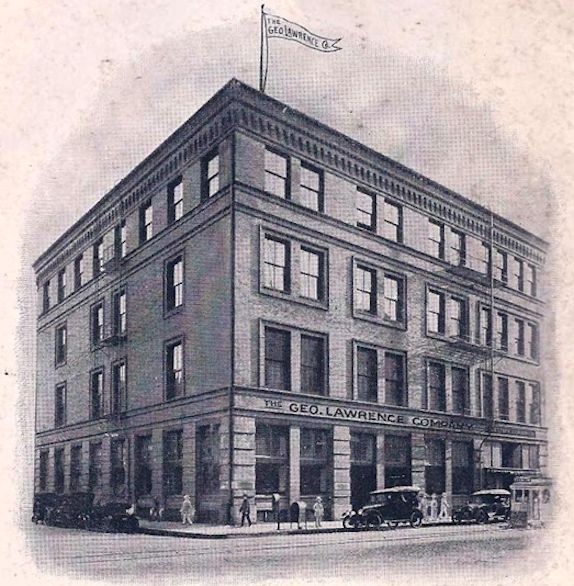 Mouse over image to see building as it looks today.
|
The subject holster could be an earlier, discontinued style, based on several factors including, but not limited to, the Lawrence trademark embossed snap fastener and rivets, which were discontinued by 1940 at the latest, but is impossible to determine due to the lack of availability, for this article, of any Lawrence catalogs prior to 1929. Pictured together is the early subject fastener Lawrence logo and a later style Lawrence fastener style logo.
As to what arrangement Stoeger had with the George Lawrence Company is unknown, however it must have been short. However, this arrangement did not resemble the arrangement between Abercrombie & Fitch and the Heiser Holster Company. The subject holster was apparently made by the George Lawrence Company for A.F. Stoeger, Inc. The holster sports the prominent Lawrence trademark logo marked fastener and rivets, equally promoting the Lawrence Company, as much as it does A.F. Stoeger, Inc. In addition, the association may have been fleeting with the 1930 or earlier A.F. Stoeger catalog, page 68, exclusive offering of Heiser holsters to their customers.
Per an old time holster collector and dealer, the Stoeger Auerhahn holster logo was discontinued by the early 1930s and has to be accepted on faith as there is no supporting documentation. The first ever published Stoeger holster to sport the Auerhahn logo which was seen on the 1920s and early 1930s Stoeger catalog covers, starting with the first September 15th, 1924 catalog. This is the only one of a few holsters identified with this unusual, rare combination of Stoeger and Lawrence features. For more information on the George Lawrence Company visit the web site titled Vintage Gun Leather.
Since the writing of this article a collector has submitted an example of an A.F. Stoeger, Inc. Auerhahn logo stamped holster, made by the George Lawrence Co. of Portland, Oregon for a Luger. The Lawrence style number 14 is a relatively common full cover flap holster Lawrence offering, seen in many of their catalogs, while the other markings on the Stoeger Auerhahn logo holster are very exact, being 7.65L,- 3¾ with L for Luger, 7.65 for the caliber and 3¾ for the barrel length. These markings represent the specific A.F. Stoeger, Inc. DWM/BKIW 1920s contract order characteristics, for literally thousands of this commercial model Luger.
Lawrence also independently sold the identical style holster for the same model commercial Luger, except with their early “football” style STEERHIDE logo stamped: George Lawrence Co., Portland, Oregon. It is clear that the Lawrence logo was applied by the Lawrence Company at manufacture, as was the Stoeger Auerhahn logo and, it is fairly certain that Lawrence had a 1920s contract with Stoeger for holsters for several pistol makers, other than Luger and that this particular contract Luger holster was specifically stamped, including the Stoeger Auerhahn logo by Lawrence, using their numeric and letter fonts for the 7.65L, and 3¾ stampings were applied per the Stoeger contract with Lawrence. It is interesting to note that the Auerhahn Stoeger holster made by the George W. Lawrence Co., Portland, Oregon with its 7.65 L (30 Cal Luger) stamping was clearly intended for the 1920s Stoeger contract imported 30 Cal P.08 style Lugers. Pictured below are both model 14 holsters, one made for the 1920s Stoeger contract Lugers and the other a Lawrence generic offering, also for Stoeger contract Lugers and other 1920s imported Lugers.
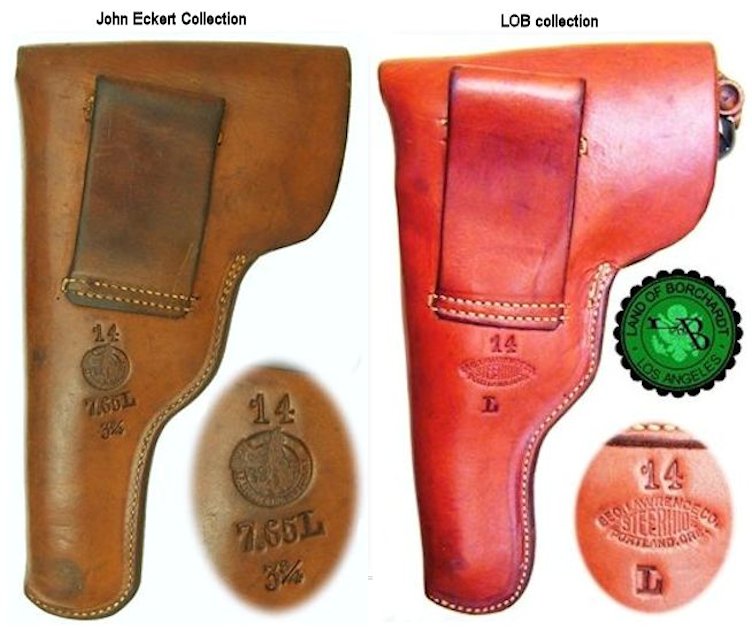
Also shown are two other Auerhahn logo stamped holsters, one pictured in Luger Holsters and Their Accessories by E. Bender on page 619, which could have been made by Lawrence, unfortunately, due to the poor quality black and white picture, no discernible Lawrence specific marks can be seen. The lack of any Lawrence markings could be due to the fact that the author states in the text description that the Auerhahn logo stamped belt loop was added to the holster by the leather maker, implies two scenarios:
- that the holster was modified by the “original leather crafter” (unknown), highly unlikely
- and/or came from another holster, leaving doubt as to the maker of the holster proper.
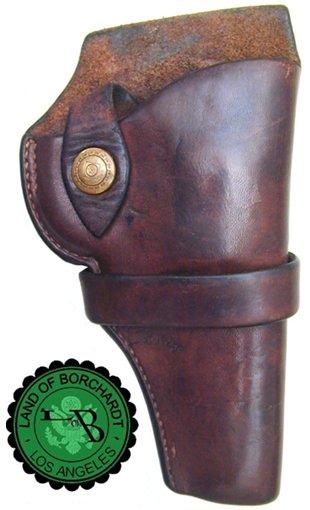
The second holster shown above is of the same Lawrence style 25 featured above with all the same features, except it is for a .32 Cal, 3½ inch barrel for an Iver Johnson revolver. The holster stamping of 3 ½ inches on the Stoeger offered holster is interesting inasmuch as the 1924 and 1930 Stoeger catalogs have full page ads for multiple Iver Johnson revolver models and all, when specifying the several barrel lengths available, all offer an Iver Johnson revolver barrel length of 3 or 3 ¼ inches and none for 3 ½ inches.
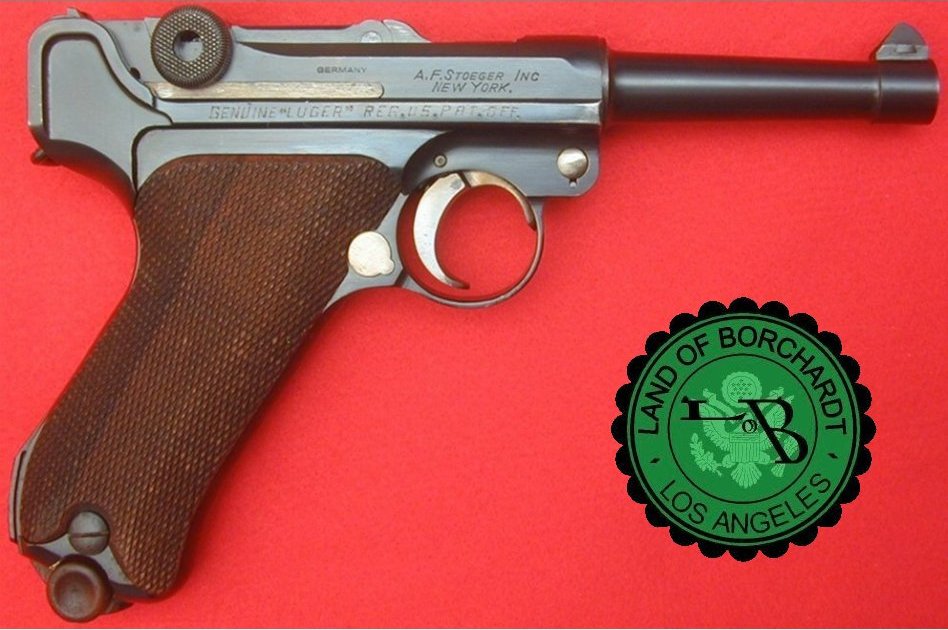
Run mouse over image to change view.


